Artigo
| Spectroscopic study of effects of tetraalkylammonium cations on F−-sensing properties of calix[4]pyrrole boradiazaindacene dye |
|
Yongjun Lv*
College of Material and Chemical Engineering, Sichuan University of Science and Engineering, Zigong, 643000, China Recebido em 08/01/2016 *e-mail: yongjunlv@qq.com A novel meso-tetracyclohexylcalix[4]pyrrole-based boradiazaindacene dye 3 was synthesized and characterized. F−-binding properties of the dye in the presence of tetrabutylammonium (TBA+), tetraethylammonium (TEA+), and tetramethylammonium (TMA+) counter ions were investigated by UV-Vis, fluorescence, and NMR spectroscopies. Dye 3 displayed various degrees of absorption red shift, fluorescence quenching, and downfield shifts of NH signals for the three fluoride salts. The association constants of these salts mainly depend on cation size effects and ion-pairing effects and were in the order KTMA+ > KTEA+ > KTBA+. Thus, we speculate that both F− and tetraalkylammonium cations are concomitantly located above and below a bowl-shaped calix[4]pyrrole cup in an ion-paired complex, respectively. INTRODUCTION Calix[4]pyrrole, as a pyrrole-derived macrocycle, was first reported as an efficient halide anion receptor by Sessler's group in 1996.1 Since then, calix[4]pyrrole-based receptors have attracted an increasing attention to modulate the anion-binding affinity and selectivity of the parent calix[4]pyrrole.2-6 In general, calix[4]pyrrole derivatives are prepared to sense halide anions through hydrogen bonds7,8 or the ion-pairing effect.9,10 In an anion-sensing process, tetrabutylammonium (TBA+) cation salts are readily utilized, yet the effects of various tetraalkylammonium cations have been largely ignored. Sessler and co-workers elucidated that cations of different sizes can affect the anion-binding affinity of calixpyrroles in the solid state.11 However, this effect in solution has not been studied in detail. As a result, we herein report the F--binding properties of calix[4]pyrrole boradiazaindacene (BODIPY) in CH3CN solution using tetrabutylammonium fluoride (TBA-F), tetraethylammonium fluoride (TEA-F), and tetramethylammonium fluoride (TMA-F) salts. Their sensing properties were investigated by UV-Vis, fluorescence, and NMR spectroscopies. With the introduction of a BODIPY fluorophore on a calix[4]pyrrole, F−-recognition processes can be monitored by colorimetric and fluorometric dual-channel patterns.12-17
EXPERIMENTAL Materials and methods All reagents were commercially obtained and used without further purification. In titration experiments, F- was added in the form of TBA+, TEA+, and TMA+ salts. The fluoride salts were purchased from Alfa Aesar and were stored in a desiccator under vacuum. Chromatography-grade CH3CN was used. 1H NMR and 13C NMR spectra were obtained using a Varian 400 MHz INOVA spectrometer with the samples dissolved in CDCl3. ESI-MS spectra were obtained using a Waters Micromass ZQ-4000 mass spectrometer. C, H, N elemental analyses were performed using Vario-EL. UV-Vis spectra were obtained using a PerkinElmer Lambda 35 spectrometer. Fluorescence spectra were obtained using a PerkinElmer LS55 spectrometer. All experiments were conducted at room temperature (25 °C). A solution of BODIPY dye 3 (1.1 x 10−3 mol L−1) in CH3CN was prepared and diluted to a concentration appropriate for UV-Vis and fluorescence spectroscopies; the appropriate F− salt (TBA-F, TEA-F, or TMA-F) dissolved in CH3CN was added to attain the F− concentration of 1.1 x 10−2 mol L−1, and the absorption/emission spectra of the resulting solution were immediately obtained. Nonlinear curves were fit to the absorption and fluorescence data and were expressed as equations (1) and (2), respectively.18   where A and A0 are the absorbance of dye 3 in the presence and absence of F-, respectively, FI and FI0 are their corresponding fluorescence intensities, CF and CD are the concentrations of F- and dye 3, respectively, and K is the association constant. Synthesis of 3-[2-(β-tetracyclohexylcalix[4]pyrrolyl)ethenyl]-4,4-difluoro-8-(4-bromo)phenyl-1,5,7-trimethyl-3a,4a-diaza-4-bora-s-indacene (3) Targeted dye 3 was prepared as shown in Scheme 1. Compound 119 (0.91 g, 2.00 mmol) and formylcalix[4]pyrrole 2 (1.23 g, 2 mmol) were refluxed in a mixture of dry toluene (50 mL), piperidine (0.5 mL), and AcOH (0.5 mL). The mixture was heated for 10 h in a Dean-Stark apparatus to azeotropically remove any water formed. The solvents were removed under reduced pressure, and the product was purified by column chromatography (CH2Cl2/hexane, 1:1) to obtain 3 as a purple solid (0.70 g). Yield: 35%. M.p. > 300 °C. ESI-MS: m/z = 1001.3 (M + H+). 1H NMR (400 MHz, CDCl3) δ: 1.42 (s, 6H, CH3), 1.49 (m, 30H, CH2), 2.00 (m, 10H, CH2), 2.60 (s, 3H, CH3), 5.88-6.00 (m, 7H, pyrrolic CH), 5.91-5.94 (m, 2H, pyrrolic CH), 5.96 (d, 3.2 Hz, 2H, pyrrolic CH), 6.40 (d, J = 2.4 Hz, 1H, NH), 6.49 (s, 1H, NH), 7.16 (s, 2H, 2NH), 7.18-7.24 (m, 2H, 1H for vinylic, 1H, CH), 7.63-7.67 (m, 3H, 2H for ArH, 1H for vinylic). 13C NMR (100 MHz, CDCl3) δ: 14.7, 14.7, 15.0, 115.8, 116.9, 117.8, 121,4, 123.3, 129.3, 129.4, 130.1, 132.4, 134.1, 136.5, 138.3, 142.1, 142.4, 142.5, 153.8, 153.8, 155.1, 156.7. Anal. calcd. for 3 (C60H68BBrF2N6): C, 71.93; H, 6.84; N, 8.39. Found: C, 71.96; H, 6.90; N, 8.34.
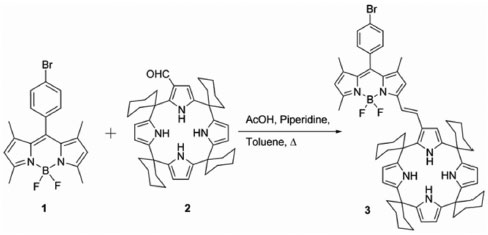 Scheme 1. Synthetic procedure for dye 3
RESULTS AND DISCUSSION UV-Vis spectral studies Figure 1 shows changes in the UV-Vis spectra of 3 (1.1 x 10−5 mol L−1) upon titration with the CH3CN solution of TBA-F. Dye 3 exhibits a typical absorption band at 590 nm; this band is red shifted by 90 nm compared to the corresponding band of parent BODIPY 1 (λab = 499 nm). This absorption shift is attributed to the extension of π-electron conjugation systems with the modification of the calixpyrrole unit on the BODIPY core.20 With the stepwise addition of TBA-F, the absorbance intensity at 590 nm decreased and a new band gradually appeared at 609 nm. The color correspondingly changed from fuchsia to blue (Figure 1 inset). These observed changes were attributed to the activated intramolecular charge transfer (ICT) process by F− binding.21 Interestingly, adding TEA-F and TMA-F caused similar changes in the UV-Vis spectra and color of the solution, as evident in Figures 1S and 2S (Supplementary Material). However, on a per molar basis, the addition of TMA-F caused the greatest absorption band red shift, followed by the red shifts caused by the additions of TEA-F and TMA-F. On the basis of the UV-Vis data, we determined the association constants K (Figure 1 inset);22 the results are shown in Table 1. The F−-binding order is KTMA+ > KTEA+ > KTBA+, opposite the order of their size. Specifically, TMA+, as a relatively small cation, is prone to associate with an electron-rich bowl-shaped cavity of the calix[4]pyrrole unit. This good match between the cation size and cavity would promote strong hydrogen bonding interactions between four pyrrolic hydrogen atoms and fluoride ions.23
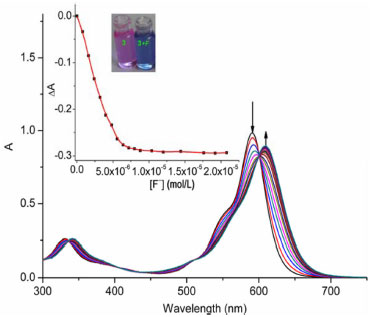 Figure 1. UV-Vis spectra of 3 (1.1 x 10−5 mol L−1) in CH3CN upon the addition of TBA-F from 0 to 2.1 x 10−5 mol L−1. Inset: nonlinear curve fitting as a function of [F-] monitored at 591 nm
Fluorescence studies The fluorescence spectrum of dye 3 exhibits a typical emission band at 623 nm, as shown in Figure 2. The quantum yield was determined to be 0.04 using rhodamine B (Φ = 0.49 in EtOH) as a standard.24 Compared to the emission wavelength of parent BODIPY 1 (λem = 510 nm), that of 3 exhibits a red shift of approximately 110 nm, which reveals the ICT nature of the excited states of 3. The addition of TBA-F resulted in obvious fluorescence quenching at 623 nm and a 20-nm blue shift; these sensing events instantaneously occurred upon the addition of F- (Figure 2 inset). The disappearance of red fluorescence is ascribed to the occurrence of an ICT process from an electron-rich calix[4]pyrrole unit upon binding F− to an electron-deficient BODIPY group. The blue shift may be due to a slight twist of the conjugated pyrrole BODIPY plane after the coordination of F−, which affects the co-planarity of the entire structure of molecule 3.25
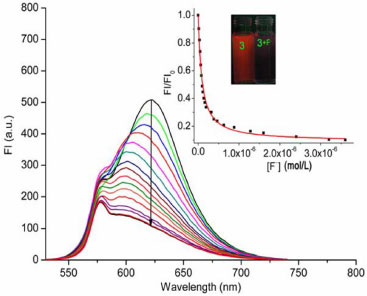 Figure 2. Fluorescence spectra of 3 (1.1 x 10−6 mol L−1) in CH3CN upon addition of TBA-F at concentrations from 0 to 3.6 x 10−6 mol L−1. Inset: nonlinear curve fitting as a function of [F−] monitored at 623 nm. Excitation was at 580 nm
The additions of TEA-F and TMA-F induced similar fluorescence changes (Figures 3S and 4S, Supplementary Material). However, quenching exhibited the trend TBA+ < TEA+ < TMA+ on a per molar basis. This order is related to the structure of tetraalkylammonium cations and to the affinity of 3 for fluoride. Similarly, association constants were also determined using equation (2), and lower detection limits were determined as three times the signal-to-noise ratio; the results are reported in Table 1.26 As reported in the table, good agreement is observed between K values and those obtained from UV-Vis analyses. Fluorescence titrations indicated that 3 demonstrates a stronger affinity for TMA-F compared with the other two fluoride salts. 1H NMR spectral studies The interactions of 3 with F− were further validated by 1H NMR experiments. Figure 3 shows partial spectra of 3 upon the addition of 2.0 equivalents of F− with different cations. The signals of NH protons at 6.40, 6.49, and 7.16 ppm disappeared, and downfield shifted to various degrees, which suggests the formation of a 3-F− hydrogen-bonding complex. The signals of the NH proton shifted to 12.42 and 12.92 ppm for TBA-F, 12.50 and 13.02 ppm for TEA-F, and 12.54 and 13.08 ppm for TMA-F. The downfield shifts also followed this order. As a result, we can reasonably speculate about the proposed interaction model of 3 and tetraalkylammonium fluoride salts (Figure 4). The F− and tetraalkylammonium cations were concomitantly located above and below the bowl-shaped calix[4]pyrrole cup. The formation of an ion-pairing complex may be based on a stepwise binding mechanism, whereby a calix[4]pyrrole subunit binds the F− anion initially to form a cone-conformation anionic complex with an electron-rich cavity opposed to the bound F−. The short distance between the F− ion and N atom in the cation would afford a close-contact ion-pairing arrangement. The hydrogen bonding interaction and affinity of 3 for F− would increase.27-29 Therefore, TMA+, as the smallest quaternary ammonium cation among those tested, was found to induce substantial spectroscopic responses in the F− recognition process of dye 3.
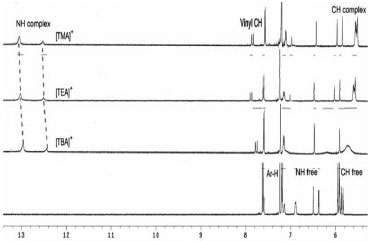 Figure 3. Partial 1H NMR spectra of 3 (1.1 x 10−2 mol L−1) in CDCl3 and in the presence of 2.0 equivalents of F− as TBA+, TEA+, and TMA+ salts
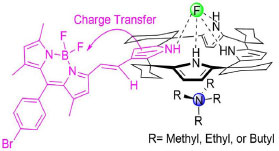 Figure 4. Proposed interaction model of 3 and tetraalkylammonium fluoride salts
CONCLUSIONS We investigated the F−-binding properties of a calix[4]pyrrole BODIPY 3 in the presence of TBA+, TEA+, and TMA+ as counter ions. Upon the addition of F−, the UV-Vis wavelength of the maximum absorption of 3 exhibited a 90-nm red shift, the color of the solution changed from fuchsia to purple, fluorescence was quenched, and pyrrole NH signals in the 1H NMR spectrum shifted downfield. Sensing responses were attributed to the ICT process from the electron-rich calix[4]pyrrole to electron-withdrawing BODIPY core. Moreover, the trend of association constants was KTMA+ > KTEA+ > KTBA+, which is a consequence of the magnitude of cation size effects and ion-pairing effects. Specifically, ion-pairing interactions can cooperatively strengthen hydrogen bonds, which would contribute to enhancing the affinity of 3 toward F− anions. Studies of the effects of tetraalkylammonium cations combined with other anions such as Cl−, Br−, I−, H2PO4−, and AcO− are currently underway.
ACKNOWLEDGMENTS This work was supported by the Foundation of Sichuan Educational Committee (No. 16ZA0260), the Scientific Research Fund of Sichuan University of Science and Engineering (No. 2012RC02), and the Sichuan Province Science and Technology Innovation Talent Project (No. 2015026).
SUPPLEMENTARY MATERIAL UV-Vis spectra and fluorescence spectra of 3 in CH3CN upon the addition of TEA-F and TMA-F are available. Supplementary material associated with this article can be found, in the online version, at http://www.quimicanova.sbq.org.br/.
REFERENCES 1. Gale, P. A.; Sessler, J. L.; Lynch, K. V.; J. Am. Chem. Soc. 1996, 118, 5140. DOI: http://dx.doi.org/10.1021/ja960307r 2. Kim, D. S.; Sessler, J. L.; Chem. Soc. Rev. 2015, 44, 532. DOI: http://dx.doi.org/10.1039/C4CS00157E PMID: 24984014 3. Chang, K. C.; Minami, T.; Koutnik, P.; Savechenkov, P. Y.; Liu, Y.; Anzenbacher, P. J.; J. Am. Chem. Soc. 2014, 136, 1520. DOI: http://dx.doi.org/10.1021/ja411391c PMID: 24392650 4. Liu, Y.; Minami, T.; Nishiyabu, R.; Wang, Z.; Anzenbacher, P. J.; J. Am. Chem. Soc. 2013, 135, 7705. DOI: http://dx.doi.org/10.1021/ja4015748 PMID: 23656505 5. Kim, S. K.; Gross, D. E.; Cho, D. G.; Lynch, V. M.; Sessler, J. L.; J. Org. Chem. 2011, 76, 1005. DOI: http://dx.doi.org/10.1021/jo101882r PMID: 21141913 6. Nielsen, K. A.; Cho, W. S.; Lyskawa, J.; Levillain, E.; Lynch, V. M.; Sessler, J. L.; Jeppesen, J. O.; J. Am. Chem. Soc. 2006, 128, 2444. DOI: http://dx.doi.org/10.1021/ja055483r PMID: 16478201 7. Choi, J. H.; Cho, D. G.; Tetrahedron. Lett. 2013, 54, 6928. DOI: http://dx.doi.org/10.1016/j.tetlet.2013.10.046 8. Yoon, J.; Kim, M. S.; Hong, S. J.; Sessler, J. L.; Lee, C. H.; J. Org. Chem. 2009, 74, 1065. DOI: http://dx.doi.org/10.1021/jo802059c 9. Kim, S. K.; Sessler, J. L.; Acc. Chem. Res. 2014, 47, 2525. DOI: http://dx.doi.org/10.1021/ar500157a PMID: 24977935 10. Kim, S. K.; Sessler, J. L.; Chem. Soc. Rev. 2010, 39, 3784. DOI: http://dx.doi.org/10.1039/c002694h PMID: 20737073 11. Sessler, J. L.; Gross, D. E.; Cho, W. S.; Lynch, V. M.; Schmidtchen, F. P.; Bates, G. W.; Light, M. E.; Gale, P. A.; J. Am. Chem. Soc. 2006, 128, 12281. DOI: http://dx.doi.org/10.1021/ja064012h PMID: 16967979 12. Lv, Y.; Xu, J.; Guo, Y.; Shao, S.; Chem. Pap. 2011, 65, 553. 13. Lv, Y.; Xu, J.; Guo, Y.; Shao, S.; J. Inclusion Phenom. Macrocyclic Chem. 2012, 72, 95. DOI: http://dx.doi.org/10.1007/s10847-011-9946-1 14. Gotor, R.; Costero, A. M.; Gacina, P.; Gil, S.; Parra, M.; Eur. J. Org. Chem. 2013, 2013, 1515. DOI: http://dx.doi.org/10.1002/ejoc.201201504 15. Taner, B.; Kursunlu, A. N.; Güler, E.; Spectrochim. Acta, Part A 2014, 118, 903. DOI: http://dx.doi.org/10.1016/j.saa.2013.09.077 16. Kursunlu, A. N.; Sahin, E.; Güler, E.; RSC Adv. 2015, 5, 5951. DOI: http://dx.doi.org/10.1039/C4RA12874E 17. Kursunlu, A. N.; RSC Adv. 2015, 5, 41025. DOI: http://dx.doi.org/10.1039/C5RA03342J 18. Liu, W.; Xu, L.; Sheng, R.; Wang, P.; Li, H.; Wu, S.; Org. Lett. 2007, 9, 3829. DOI: http://dx.doi.org/10.1021/ol701620h PMID: 17705397 19. Zhang, X.; Xiao, Y.; Qian, X.; Org. Lett. 2008, 10, 29. DOI: http://dx.doi.org/10.1021/ol702729u PMID: 18069840 20. Louder, A.; Burgess, K.; Chem. Rev. 2007, 107, 4891. DOI: http://dx.doi.org/10.1021/cr078381n 21. Baruah, M.; Qin, W.; Flors, C.; Hofkens, J.; Vallee, R. A.; Beljonne, D.; Auweraer, M. V.; Borggraeve, W. M.; Boens, N.; J. Phys. Chem. A 2006, 110, 5998. DOI: http://dx.doi.org/10.1021/jp054878u PMID: 16671668 22. Connors, K. A.; Binding Constants: The Measurement of Molecular Complex Stability, Wiley-VCH: New York, 1987. 23. Bates, G. W.; Gale, P. A.; Light, M. E.; CrystEngComm. 2006, 8, 300. DOI: http://dx.doi.org/10.1039/B600251J 24. Almonasy, N.; Neoras, M.; Hykova, S.; Lycka, A.; Cermak, J.; Dvorak, M.; Michl, M.; Dyes Pigm. 2009, 82, 164. DOI: http://dx.doi.org/10.1016/j.dyepig.2008.12.009 25. Valeur, B.; Molecular Fluorescence, Principles and Applications, Wiley-VCH: New York, 2002. 26. Shortreed, M.; Kopelman, R.; Kuhn, M.; Hoyland, B.; Anal. Chem. 1996, 68, 1414. DOI: http://dx.doi.org/10.1021/ac950944k PMID: 8651501 27. Park, I. W.; Yoo, J.; Kim, B.; Adhikari, S.; Kim, S. K.; Yeon, Y.; Haynes, C. J. E.; Sutton, J. L.; Tong, C. C.; Lynch, V. M.; Sessler, J. L.; Gale, P. A.; Lee, C. H.; Chem.-Eur. J. 2012, 18, 2514. DOI: http://dx.doi.org/10.1002/chem.201103239 28. Park, I. W.; Yoo, J.; Adhikari, S.; Parl, J. S.; Sessler, J. L.; Lee, C. H.; Chem.-Eur. J. 2012, 18, 15073. DOI: http://dx.doi.org/10.1002/chem.201202777 29. Ciardi, M.; Tancini, F.; Gil-Ramirez, G.; Adan, E. C. E.; Massera, C.; Dalcanale, E.; Balester, P.; J. Am. Chem. Soc. 2012, 134, 13121. DOI: http://dx.doi.org/10.1021/ja305684m PMID: 22809359 |
On-line version ISSN 1678-7064 Printed version ISSN 0100-4042
Qu�mica Nova
Publica��es da Sociedade Brasileira de Qu�mica
Caixa Postal: 26037
05513-970 S�o Paulo - SP
Tel/Fax: +55.11.3032.2299/+55.11.3814.3602
Free access






